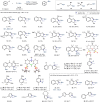Organometallic-type reactivity of stable organoboronates for selective (hetero)arene C-H/C-halogen borylation and beyond
- PMID: 40595517
- PMCID: PMC12216623
- DOI: 10.1038/s41467-025-60674-9
Organometallic-type reactivity of stable organoboronates for selective (hetero)arene C-H/C-halogen borylation and beyond
Abstract
Organometallic reagents are essential tools in both academic and industrial laboratories and the polarity separation within the carbon-metal bonds endows them with exceptional reactivities, but also imposes limitations, including air- and moisture-sensitivity, and flammability. Here, we demonstrate that stable and easily accessible benzylic (or allylic) boronate with alkali-metal alkoxide as the activator can act as reactive organometallic reagents. This strategy enables transition metal-free deprotonative C-H borylation of diverse (hetero)arenes. The polar organometallic nature of this process enables predictable and site-selective borylation by targeting the arenes's most acidic C-H bond. This approach can be coupled with Suzuki-Miyaura reaction to produce C-H arylation products. We have also applied this strategy to the dehalogenative borylation of aryl bromides and anionic polymerization of styrenes. Given the unique stability and structural diversity of organoboronates, their organometallic-type reactivities show promise as a powerful alternative to synthetic methodologies that rely on sensitive organometallic reagents.
© 2025. The Author(s).
Conflict of interest statement
Competing interests: The authors declare no competing interests.
Figures





Similar articles
-
Home treatment for mental health problems: a systematic review.Health Technol Assess. 2001;5(15):1-139. doi: 10.3310/hta5150. Health Technol Assess. 2001. PMID: 11532236
-
Assessing the comparative effects of interventions in COPD: a tutorial on network meta-analysis for clinicians.Respir Res. 2024 Dec 21;25(1):438. doi: 10.1186/s12931-024-03056-x. Respir Res. 2024. PMID: 39709425 Free PMC article. Review.
-
Education support services for improving school engagement and academic performance of children and adolescents with a chronic health condition.Cochrane Database Syst Rev. 2023 Feb 8;2(2):CD011538. doi: 10.1002/14651858.CD011538.pub2. Cochrane Database Syst Rev. 2023. PMID: 36752365 Free PMC article.
-
Signs and symptoms to determine if a patient presenting in primary care or hospital outpatient settings has COVID-19.Cochrane Database Syst Rev. 2022 May 20;5(5):CD013665. doi: 10.1002/14651858.CD013665.pub3. Cochrane Database Syst Rev. 2022. PMID: 35593186 Free PMC article.
-
Thrombolysis for acute ischaemic stroke.Cochrane Database Syst Rev. 2003;(3):CD000213. doi: 10.1002/14651858.CD000213. Cochrane Database Syst Rev. 2003. Update in: Cochrane Database Syst Rev. 2009 Oct 07;(4):CD000213. doi: 10.1002/14651858.CD000213.pub2. PMID: 12917889 Updated.
References
-
- Schlosser, M. Organometallics in Synthesis: Third Manual. (John Wiley & Sons, Inc., 2013).
-
- Reich, H. J. Role of organolithium aggregates and mixed aggregates in organolithium mechanisms. Chem. Rev.113, 7130–7178 (2013). - PubMed
-
- Robertson, S. D., Uzelac, M. & Mulvey, R. E. Alkali-metal-mediated synergistic effects in polar main group organometallic chemistry. Chem. Rev.119, 8332–8405 (2019). - PubMed
-
- Tilly, D., Chevallier, F., Mongin, F. & Gros, P. C. Bimetallic combinations for dehalogenative metalation involving organic compounds. Chem. Rev.114, 1207–1257 (2014). - PubMed
-
- Vidal, C., García-Álvarez, J., Hernán-Gómez, A., Kennedy, A. R. & Hevia, E. Exploiting deep eutectic solvents and organolithium reagent partnerships: Chemoselective ultrafast addition to Imines and quinolines under aerobic ambient temperature conditions. Angew. Chem. Int. Ed.55, 16145–16148 (2016). - PubMed
Grants and funding
LinkOut - more resources
Full Text Sources

